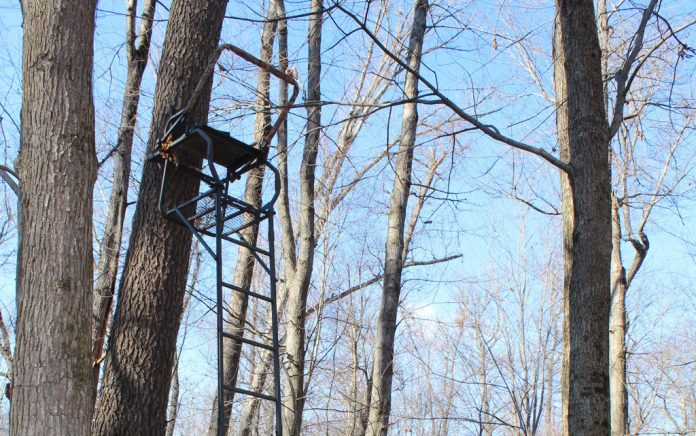There is no such thing as a safety guarantee when it comes to hunting from a tree stand, whether it’s a climber, ladder stand, reached by strap-on or screw-in steps, or ladder.
There are simply too many statistics that each tell a painful story.
While placing a ladder stand this morning — the first day this fall when I could enlist a helper — we scoped out a corner that looked promising. We selected a chubby fence line walnut tree that offered all the right things — a solid trunk with enough lumber and limbs to give the stand location a bit of cover and intersecting game trails within easy arrow range.
Set up
I will not set a tree stand by myself and for good reason; it’s dangerous. Son-in-law Dave Miller and I built the stand by pushing sections up the trunk high enough to place another section of ladder under and into the stems of the section above.
After assuring ourselves that the section was solid and secure we repeated the process.
Climbing a stand for the first time is another two-person operation. Until the seat is strapped tightly to the tree and additional stiffening straps or lines are attached to the ladder, it can tip or roll to the side.
Oh, about that ratchet strap, if it’s from last year, throw it away.
Falling
And you might want to clear the ground around the base of the ladder of objects that can trip one in the dark or daylight.
On this day, I stepped on a walnut and took a flop that could have been worse.
Tree stand safety starts at home. Before heading to the woods, look for rusted bolts and other fasteners, tie-down lines, cables, and the structure itself.
It may seem like a short while since you purchased your favorite climber or ladder, but it’s more likely to be several years ago and each season takes a toll on a stand.
One tree stand company estimates that up to a third of tree stand users will at some time have an accident of some degree.
That’s a pretty scary statistic and ought to get the attention of climbing hunters.
Tips
The following safety tips are strongly suggested by various stand makers. If all are followed carefully and faithfully, a life or serious injury might be prevented.
At the very least, understand how to shorten the list of elevated hunting hazards.
– Be sure to select the proper tree before hanging a fixed-position stand or using a climbing stand. The tree should be alive and healthy without any noticeable rot or damage.
Your tree should also meet the size specifications and restrictions set by the tree stand company.
– Never hunt from a tree stand without a secure and high-quality safety system, harness or vest.
It only takes one fall to suffer a serious injury or permanently end your hunting career. A strong and sturdy safety rope (or strap) should be attached to both your harness and the tree to prevent you from falling more than 12 inches.
Continuously monitor and inspect your safety harness and tree stands before and during the season to check for wear and tear or possible damage.
When hunting from a fixed position or hang-on stand always inspect the ladder steps and tree stand attachments to make sure everything is tightly secured to the tree.
– Always use a haul line to pull-up your gear, bow or unloaded firearm.
Never climb with anything in your hands or attached to your back. Before climbing down, use the haul line to safely lower all of your equipment on the opposite side of the tree.
– Be sure to let family and friends know the exact tree stand location that you’re currently hunting.
When at all possible, hunt with a buddy and always carry a like a cellphone or communication devise easily reachable on your body at any time.
It’s also smart to leave a note on your dashboard.
– Follow the 3-point rule, which says always have 3-points of contact to your steps or ladder when climbing or descending from your stand.
Be aware of slippery and hazardous climbing conditions that may result from rain, sleet, snow or ice and take the appropriate precautions.
When using a climbing stand, make slow, steady and even movements of no more than 12 inches at a time. You should also make sure the climbing section and platform of your stand are attached together by some type of safety cord or rope.
Continually read about and discuss tree stand safety and insist that your hunting buddies and family members practice step-by-step tree stand safety.













